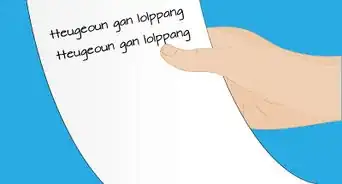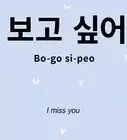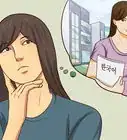This article was co-authored by wikiHow staff writer, Jennifer Mueller, JD. Jennifer Mueller is a wikiHow Content Creator. She specializes in reviewing, fact-checking, and evaluating wikiHow's content to ensure thoroughness and accuracy. Jennifer holds a JD from Indiana University Maurer School of Law in 2006.
wikiHow marks an article as reader-approved once it receives enough positive feedback. This article received 23 testimonials and 89% of readers who voted found it helpful, earning it our reader-approved status.
This article has been viewed 757,024 times.
Learn more...
Learning basic greetings is important in any language. However, in a conservative culture such as Korea, it's more important to learn how to properly greet others to avoid causing offense. The standard way to say "hello" in Korean, used between adults who don't know each other, is 안녕하세요 (an-nyeong-ha-se-yo). If you're speaking to friends and relatives, there are more informal greetings you can use. There are also other words and phrases you can use to greet people depending on the context and the time of day.[1]
Steps
Showing Politeness and Respect
-
1Say 안녕하세요 (an-nyeong-ha-se-yo) when meeting someone for the first time. If you're an adult and you're talking to someone you don't know, 안녕하세요 (an-nyeong-ha-se-yo) is your best choice to say "hello." This greeting is considered rather formal and shows respect for the person you're greeting.[2]
- This greeting should also be used in any context where it's important to maintain a degree of formality, such as in the workplace, even if you're talking to someone you're friendly with.
- Children also use this greeting when saying hello to adults.
Tip: The 요 (yo) at the end of the greeting tells you that it's polite. Any time you see 요 (yo), you know that the word or phrase being used is polite and generally acceptable to use among adults to convey the proper respect.
-
2Use 안녕 (an-nyeong) when talking to children. 안녕 (an-nyeong) is a shortened, more informal version of the standard greeting 안녕하세요 (an-nyeong-ha-se-yo). This greeting is most commonly used among children and family members. However, it would rarely be used by adults unless they were greeting a child.[3]
- 안녕 (an-nyeong) is also used among friends. However, for adults over the age of 30, you'll typically only hear this greeting between women. Men rarely, if ever, use it unless talking to a child. In Korean society, it is generally seen as inappropriate for an adult man to be using an expression that children use.
Tip: 안녕 (an-nyeong) is used to mean both "hello" and "goodbye." However, 안녕하세요 (an-nyeong-ha-se-yo) is only used to mean "hello."
Advertisement -
3Try other informal greetings if you are an adult man. An adult man in Korea would never greet his friends with 안녕 (an-nyeong) because it is a phrase used by women and children. However, there are a number of other phrases adult men use to greet friends that are a little less formal than 안녕하세요 (an-nyeong-ha-se-yo) but still convey the proper politeness. These greetings include:[4]
- 반갑다! (ban-gap-da): This phrase means "it's good to see you" and is the most common informal greeting among adult male friends. Also may be used by teenagers and children.
- 잘 지냈어? (jal ji-ne-sseo?): Similar to "how are you," this phrase asks "have you been well?" Also a common greeting among adult male friends. Teenagers and children also use this greeting.
- 오랜만이야 (o-ren-ma-ni-ya): "Long time no see," used between adult male friends who haven't seen each other in a while. Children and teenagers will also say this to each other in the same context.
- 얼굴 보니까 좋다 (ul-gul bo-ni-gga jo-ta): "It's good to see your face," a colloquial, informal greeting used exclusively between adult friends.
-
4Listen for 안녕하십니까 (an-nyeong-ha-shim-ni-ka) in business contexts. 안녕하십니까 (an-nyeong-ha-shim-ni-ka) is a super formal way of saying "hello" in Korean, and is typically only used by a business owner who wants to show respect to their customers. It's intended to show a great deal of respect and deference.[5]
- While you won't be greeted this way in every shop or restaurant you enter in Korea, you're likely to hear it in fancier places. Airline staff will also greet you this way on a Korean airline.
- You may be greeted this way while in Korea, but you would seldom have any opportunity to use it yourself unless you work in a customer service position in Korea. If you use this phrase in any other context, it will just make the people you greet feel awkward.
-
5Accompany polite or formal greetings with a bow. When you greet anyone using a formal greeting, bend your head and waist about 45 degrees while looking down. If you're using a polite greeting with someone you know, bow 15 to 30 degrees. [6]
- The depth of your bow depends on the person and the context. Someone older than you or in a position of authority would always get a deeper bow.
- Never make eye contact with the other person when you bow. This is considered rude.
Using Other Types of Greetings
-
1Answer the phone with 여보세요 (yeo-bo-se-yo). 여보세요 (yeo-bo-se-yo) is a way of saying "hello," but it's only ever used when answering the phone. It would be inappropriate and borderline rude to use it in person or in any other context.[7]
- Because the phrase ends in 요 (yo), it is considered polite and is appropriate to use regardless of who's on the other end of the line.
-
2Switch to 좋은 아침 (jo-eun a-chim) first thing in the morning. Unlike English and many other languages, there are no distinct greetings in Korea that depend on the time of the day. However, first thing in the morning you can use 좋은 아침 (jo-eun a-chim), which literally means "good morning."[8]
- While people will understand you when you say this, it isn't a commonly used greeting. It's best used between people you know relatively well, especially if one of them has said it to you first.
-
3Say 만나서 반갑습니다 (man-na-se-o ban-gap-seum-ni-da) after being introduced to someone new. 만나서 반갑습니다 (man-na-se-o ban-gap-seum-ni-da) means, roughly, "pleased to meet you." If you meet someone in a formal or professional setting, this is the phrase to use.[9]
- Don't forget to bow while saying this unless you've already bowed.
- This phrase is also appropriate if you're meeting someone who appears to be older than you or is in a position of authority.
-
4Try 만나서 반가워요(man-na-se-o ban-ga-wo-yo) if meeting someone around your age or younger. 만나서 반가워요(man-na-se-o ban-ga-wo-yo) is the more informal version of 만나서 반갑습니다 (man-na-se-o ban-gap-seum-ni-da) and also means "nice to meet you." This phrase is appropriate when you're being introduced to someone your age or younger.[10]
- Remember to pay attention to context as well as the age of the person you're greeting. If you're meeting someone your age in a professional or formal setting, you would typically still use 만나서 반갑습니다 (man-na-se-o ban-gap-seum-ni-da). 만나서 반가워요(man-na-se-o ban-ga-wo-yo) is appropriate in a casual social setting, such as when you're introduced to the friend of a friend.
Culture Tip: If you're unsure what level of politeness to use, stick with the more polite greeting. No one will fault you for being too polite or formal, but you could cause offense if you are too casual with someone.
Community Q&A
-
QuestionHow do I say "Hello friend" in Korean?
 Community Answer안녕, 친구 (ahn-nyeong, chin-gu). 친구 (chin-gu) means friend and 안녕 (ahn-nyeong) is an informal way to say "hello" that is usually used for friends.
Community Answer안녕, 친구 (ahn-nyeong, chin-gu). 친구 (chin-gu) means friend and 안녕 (ahn-nyeong) is an informal way to say "hello" that is usually used for friends. -
QuestionHow do I say "Hello, Mom" in Korean?
 Community Answer"Eomma ahn-nyeong" (안녕 엄마) When Koreans talk, the nouns come before the verbs or action. So in English, it is "Mom, hello."
Community Answer"Eomma ahn-nyeong" (안녕 엄마) When Koreans talk, the nouns come before the verbs or action. So in English, it is "Mom, hello." -
QuestionHow do I say goodbye in Korean?
 Community AnswerFor the person who is staying, "Anyoeung eKaseyo" and the person who is leaving says, "Anyeung eKeseyo."
Community AnswerFor the person who is staying, "Anyoeung eKaseyo" and the person who is leaving says, "Anyeung eKeseyo."
Warnings
- Romanization of Korean words is a tool that can help you pronounce words and phrases more quickly. However, if you're trying to learn Korean, it's best to start learning the Korean alphabet and how to pronounce the letters first, rather than relying too much on romanization.⧼thumbs_response⧽
References
- ↑ https://omniglot.com/language/phrases/korean.php
- ↑ https://omniglot.com/language/phrases/korean.php
- ↑ https://omniglot.com/language/phrases/korean.php
- ↑ https://www.clozemaster.com/blog/hello-in-korean/
- ↑ https://www.clozemaster.com/blog/hello-in-korean/
- ↑ https://culturalatlas.sbs.com.au/south-korean-culture/south-korean-culture-greetings
- ↑ http://www.omniglot.com/language/phrases/korean.php
- ↑ https://koreabridge.net/post/how-say-%E2%80%98good-morning%E2%80%99-korean-90daykorean
- ↑ https://www.omniglot.com/language/phrases/korean.php
About This Article
To say hello in Korean, say "Annyeong" when greeting your friends or relatives. This is pronounced "ann yeong" and is a common greeting for informal situations, just like saying "hey" in English. In most other situations, use "Anyoung haseyo," pronounced "ahn-yong hah-say-yoh" instead, which is a common and respectful way to greet someone. When you answer the phone in Korean, you can say "Yeoboseyo," pronounced "yo-bo-say-yoh." This is the standard phone greeting, though it is not used in person. To learn how to say other greetings in Korean, like "Good morning," read on!
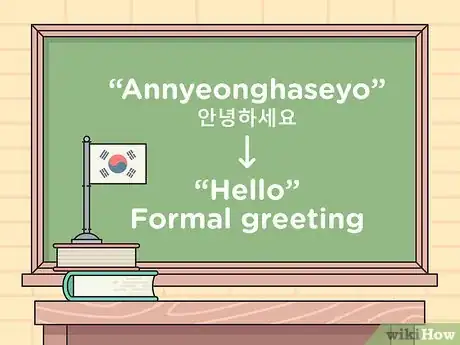
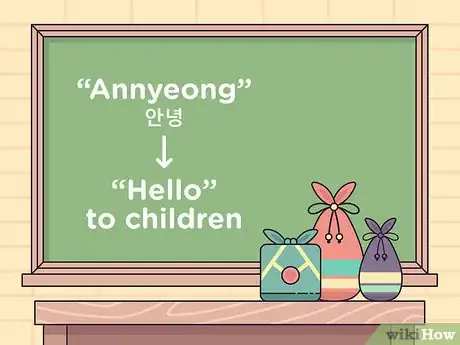

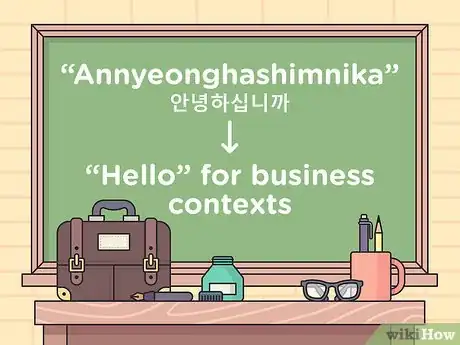
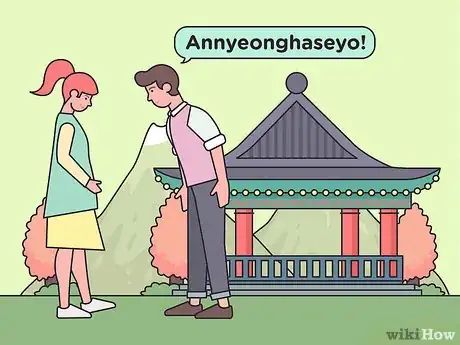
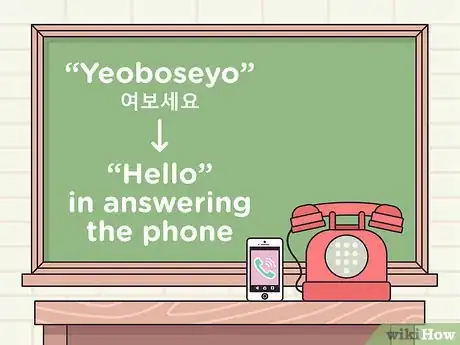
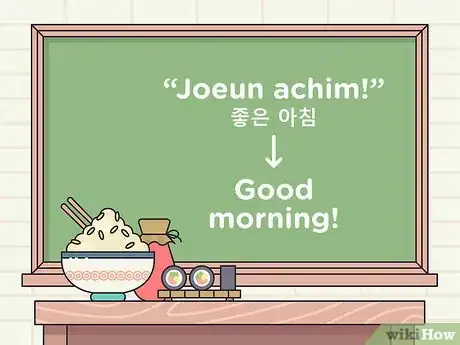
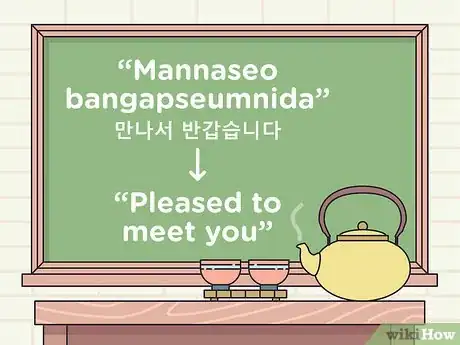
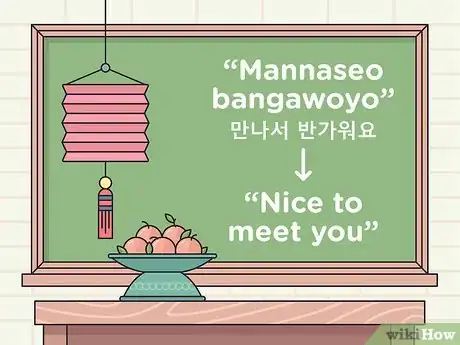
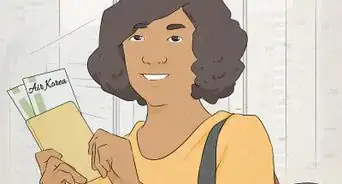
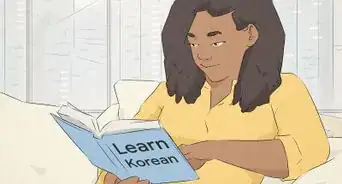
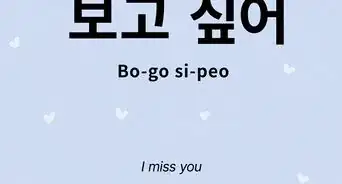

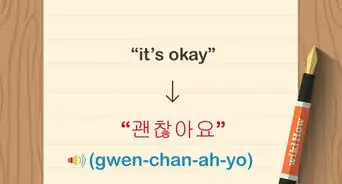

-Step-4.webp)
